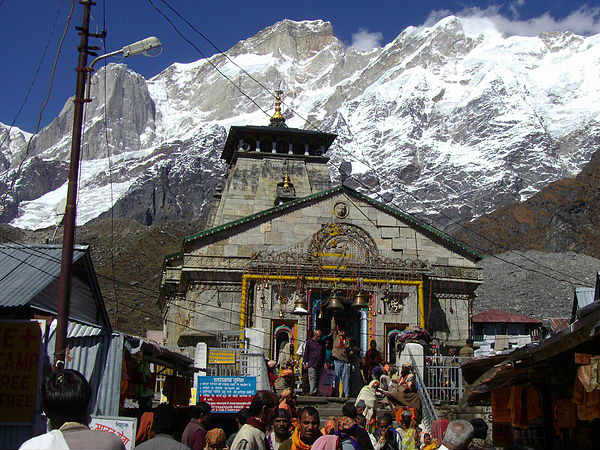
The Char Dham yatra of Uttarkhand is the name given to the four destinations of the sacred Hindu pilgrimage circuit in the Indian Himalayas. Deriving its name from the original and longer Char Dham yatra which covers the four places of Badrinath, Dwarka, Puri and Rameshwaram, the smaller itineration contains the spiritual source of four holy rivers" Yamunotri ( the source of the Yamuna), the Gangotri ( the source of the Ganges), Kedarnath ( the source of the Mandakini) and Badrinath (the source of the Alakananda). A visit to these places is supposed to wash away your sins and liberate you from the cycle of birth and death. Lakhs of pilgrims endure extreme hardships to visit these places every year. This year the Char Dham yatra starts from May 4. Let us look at what makes the Char Dham yatra of Uttarakhand so special.

Badrinath
The most popular and accessible among the temples in the Char dham yatra this temple is dedicated to Lord Vishnu and sits on the lap of the snow-topped Nilakantha peak. Badrinath temple is visited as a one day trip. To reach the temple your route will be from Haridwar or Rishikesh to Joshimath. Reaching the temple requires a perilious bus-ride on a mountain road for 10-12 hours. Buses leave every morning from 4 am to 7 am.
Pic Credit: Wiki Commons

Take Pains to Meet the Lord
From Joshimath it's another two hours to Badrinath. Traffic is only allowed to depart from Joshimath and Badrinath at certain times of the day as the road is narrow and only one-way traffic is possible. Accomodations include Sarovar Portico, which is also the costliest option available. Garhwal Mandal Vikas Nigam offers rooms and vehicles at reasonable rates. A visit to the Valley of Flowers is also recommended. Buses from Joshimath go to Govind Ghat, where the trek starts.
Pic Credit: Wiki Commons

Gangotri
The source of the holy Ganges river,Gangotri, attracts more than 300,000 visitors every year. The temple opens on the day of Akshaya Tritya every year in the last week of April or first week of May. This is symbolised by an annual procession of the Goddess Ganga back from her winter home at Mukhyamath temple. The temple closes on Diwali every year and the Goddess returns to the Mukhyamath temple.
Pic credit : Wiki Commons

How to Reach Gangotri
Gangotri temple can be reached from Rishikesh via Uttarkashi. Buses and jeeps go there and accomodation can arranged with GVMN or other guesthouses. Trekking to the actual source of the Ganges river is also possible. To reach the source which is an ice cave called gaumukh, three days trek is required with around six hours of trekking every day.
Pic credit: shimriz

Yamunotri
Relatively undeveloped compared to the other three temples, as the name suggests, the Yamunotri temple lies close to the source of the Yamuna River, the second holiest river in India which flows all the way down past the Taj Mahal. Like Gangotri, the Yamunotri also opens every eyar on Akshaya Tritya and closes on Diwali. Similarly, the goddess is carried on the opening day from the nearby village of Kharsali which is said to her mother's home.
Pic Credit: Wiki Commons

How to Reach Yamunotri
The route by road is Haridwar/Rishikesh-Dehradun-Mussoorie-Naugaon-Barkot-Hanuman Chatti. The journey to the village of Hanuman Chatti, which is around 14 kilometers from the Yamunotri temple, takes around eight hours from Rishikesh and six hours from the hill station of Mussoorie. From there, it's necessary to take a shared taxi (departs every few minutes) to Janki Chatti. Your trek starts there! It's only five kilometers to the Yamunotri temple, via Kharsali, but it's a very steep and and in some parts narrow climb. As a result, people usually take around two hours to cover the distance and it really helps if you take a locally available walking stick. If you find you don't want to walk, there are mules and men to help carry you.
You can watch the evening aarti if you stay at Yamunotri for the night. Basic accomodation is available near the temple and also at Janki Chatti and Hanuman Chatti. Unlike the source of Ganges, the source of the Yamuna river is a frozen lake and glacier located about a kilometer above the temple and it is a very difficult climb which is not advisable.
Pic Credit: Wiki Commons

Kedarnath
This is the seat of Lord Shiva and considered to be the most important of the 12 Jyotirlingas.The remotest and the holiest of the Char dhams, Kedranth temple draws more than 100,000 visitors ever year because it is the seat of Lord Shiva and the most important of the 12 Jyotirlingas. The route to Kedarnath is the same as Badrinath from Rishikesh but branches off at Rudraprayag.
Pic credit: Wiki Commons

The Long Route
The whole journey takes around 12 hours till Gaurikund. From Gaurikund, it is a gruelling uphill journey to the temple which will not take less than 6 hours. The scenic beauty of the Mandakini will keep you occupied though. Ponies and porters are available to transport you and your luggage too if in case you feel walking is not your cup of tea. Alternatively, Kedarnath temple is also accessible by helicopter. A one way trip takes 15 minutes. Accomodation can be found at Gaurikund and the temple. Here is how to reach Uttarakhand.



 Click it and Unblock the Notifications
Click it and Unblock the Notifications























